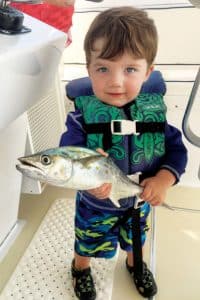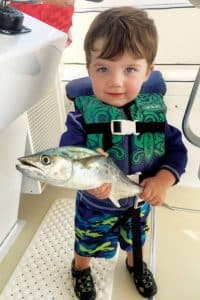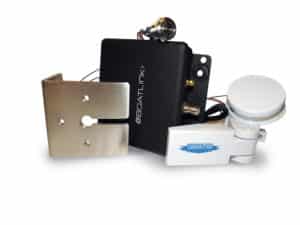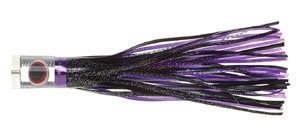
Bluewater Lures
1. How will the lure run behind my boat?
2. What are the best conditions to run it?
3. Where should it go in the spread? While most of these can be answered by simply looking at the shape of the lure’s head, we recently spent time with two of the best big-gamers in the business, Ron Schatman and Dick Tanner, to get their take on lure basics. Schatman, a charterboat captain since the ’60s, started manufacturing lures in 1984. He has been at the helm for at least a dozen 700-plus-pound marlin, he won the Bahamas Billfish Championship in 2000, and he practically wrote the book on high-speed wahoo trolling in the Bahamas. Tanner, tournament director for ESPN’s Billfish Xtreme Release League, has fished with some of the best crews in the world and has been selling lures to tackle shops for about as long as Schatman has been building them. Do we have your attention? Flat Out
On a flat-faced lure, the leading edge is perpendicular to the fishing line pulling it, with no cup or dish. It is going to pull close to the surface””very straight and fairly hard””and pop a lot, throwing water in the air and pulling a trail of bubbles. “Run it low on the face of the wave where it’s grabbing a lot,” Tanner says. “And I wouldn’t troll one when it’s flat-calm. It won’t get enough action.” Manfred Koh
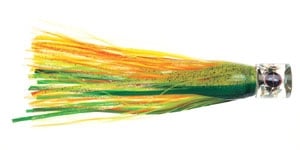
Bluewater Lures
A concave or dish-faced lure also has a leading edge that is perpendicular to the trolling line, but the face is scooped out like a satellite TV antenna. The concave face grabs more water and pulls harder, causing it to dance around in the water. This is a good lure when there’s not enough sea action to bring other lures to life. “Very few baits will out-fish it on a calm day,” says Schatman. The deeper the dish, the more pronounced this effect. And because they pull harder, concave-faced lures may stay in the water better when it’s windy. Manfred Koh
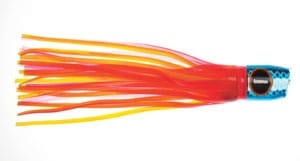
Bluewater Lures
A lure with an angled or slanted face, one that is cocked at an angle to the trolling line, will spend part of its time on the surface, being pushed out of the water by this angle, but then it will occasionally roll 180 degrees and dive under the surface. Many slant-lure designs have an offset leader hole (see “Off the Grid,” below) and lure makers also adjust the angle of the face and may add a dish or scoop to change the lure’s action. “Lures with big slants and scoop faces are very erratic,” Tanner says. “They’re often not good hookup lures, but they get the fish’s attention. Keep them short where the fish can see the rest of the spread.” Manfred Koh
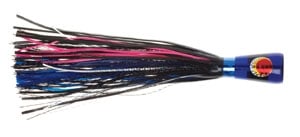
Bluewater Lures
The teardrop, a lure shape that deserves special mention, has a large, deep-dished, perpendicular face so it grabs a lot of water. It also tapers into the skirt, reducing turbulence behind the lure for what fluid dynamicists call, “laminar flow.” “It’s a very consistent lure,” Schatman says. “It will hit the surface and pop, then dive under and smoke for about four seconds before it surfaces again. If it’s sluggish, you might pick it up in the ‘rigger a bit. If it’s hopping, pull it down. See how the action changes and stay with it.” Manfred Koh
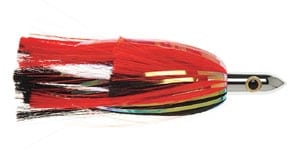
Bluewater Lures
A bullet, or rounded-nosed lure, will pull through the water with very little movement. “Run one long and lazy,” says Tanner, who likes to put one way back on the shotgun for fish that just don’t seem to like anything else. “When it’s that far back, a lure isn’t going to get any real movement.” The original Ilander is a classic bullet. “You can put a skirt over an Ilander, or inside it, add lead to it, put a ballyhoo behind, or not. It’s a great straight-running lure.” Manfred Koh
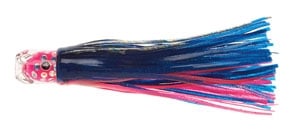
Bluewater Lures
A true jet-head, one with many holes that allow water to run through the head, will run just like a bullet, whereas vented lures with just two or three holes are going to act the way their face and body shape would dictate before the holes were added. Jets and vents also add air bubbles, but lures with sharp leading edges create more turbulence so they “smoke” much better than those with slightly radiused edges. This subtle distinction is often what separates the inexpensive knockoffs from higher-priced lures. Manfred Koh

Bluewater Lures
While it may be a shock to some, many top captains and mates swear by simple skirtless lures, such as a cedar plug. Tanner is no exception. “If I had to have just one lure to eat by, not necessarily billfishing, it would be a small skirtless lure,” Tanner says. “With no skirt there is nothing to break up the bubble trail. It just has a big cone of air running behind it.” Manfred Koh
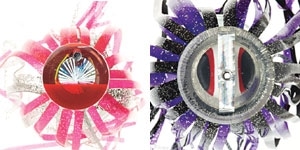
Bluewater Lures
It’s not uncommon for slant-lure designs (and even a few flat faces) to have an offset leader hole (below right)—either near the acute angle, so the lure stays on the surface more; or close to the obtuse angle, so the lure spends more time “upside down” and under water.
— V.F.D. Manfred Koh

